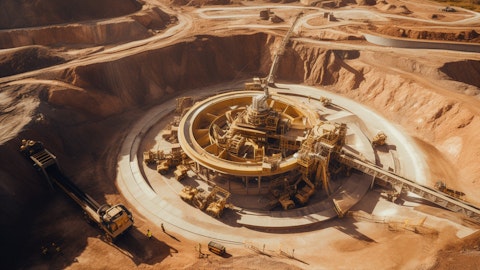Nathan Harte: Yeah, I’ll take that one. I think it’s going to be mostly Avino. I think we’re not expecting a huge contribution from La Preciosa. We’re using the stockpiles to better understand how it’s going to go through our mill. But also, obviously, we’re going to get some revenues and some positive ounces out of that as well, too, and some cost recovery. But I think we’re expecting 90%, 95% of that to come from Avino. And I think we put out our tonnage guidance as well, too. And you can see between 700,000 and 750,000, and we produced about 615,000 last year or milled 615,000. So, we are expecting improvement there. And that just comes with some better equipment on site to deal with breaking ore, us having a fairly larger stockpile at the end of the year, which I think we talked about throughout the call as well, too.
And just expecting that we’re going to produce closer to that 2,500 tonnes per day run rate and get up to 700,000, 750,000 tonnes throughout the year. And so, grade in some months is better than others. But overall throughout the year, we’re not expecting a huge movement from last year.
Matthew O’Keefe: Okay.
Nathan Harte: On that note, Matt. Sorry, Matt. On that note, last year was the first time we ran the full mill throughput with ET material. So, it’s a bit of a learning curve for us last year, and we hope to take those learnings and apply it to this year, which is explain some of the increase.
Matthew O’Keefe: Got it. Okay. Thanks. And then just — you did — you passed some pretty significant milestones this year, I would say. You produced the Oxide Tailings PFS, which was very positive, and more to come on that. And then, with La Preciosa, you now have your land use agreement. You’ll be able to access ore, which, well, I guess we’ll see more contribution from that next year. Are we still looking for a sort of a five-year plan to expand production to the 7.5 million to 9 million ounce silver equivalent range?
David Wolfin: Absolutely.
Matthew O’Keefe: Okay. Yeah, I just — I didn’t hear mention of that, maybe…
David Wolfin: So, the main focus is La Preciosa right now, get that up and running, and then community engagement on Oxide Tailings, environmental studies and that kind of thing. So that will be the last expansion. But you’ll see a big impact from La Preciosa. Hopefully, we get the permit soon.
Matthew O’Keefe: Okay. And will there be — I guess, you’ll produce more guidance as to what to expect from La Preciosa proper some — throughout 2024 into ’25. Is that a fair timeframe?
Nathan Harte: Yeah, that’s fair to say. I think we want to get, obviously, all the ducks in the row with permitting and everything in place and start the development decline and get into production, and then we’ll provide a bit more color on the expected tonnages and ounces for — and I think that will be closer for moving for 2025 projections, because as we mentioned, year 2024, we’re not actually budgeting for…
David Wolfin: The permitting dictates the timing.
Nathan Harte: Yeah. That’s correct.
Matthew O’Keefe: And that’s going okay?
David Wolfin: It’s going fine.
Matthew O’Keefe: Got it. Okay. Thanks very much.
Operator: [Operator Instructions] Our next question comes from [Rod Douglas] (ph), private investor. Please go ahead.
Unidentified Analyst: David, would it be safer to say that the land use permit was easier to get than the environmental permit?
David Wolfin: The land use permit…
Nathan Harte: You mean the community engagement, the community support, the community approval, you mean, at La Preciosa, is that correct?
Unidentified Analyst: Yes, that’s right.
David Wolfin: I wouldn’t say…
Nathan Harte: Either way.
David Wolfin: …either way. I mean, how do I know what’s easier? I mean, these things take time. We don’t expect any delays in the permitting.
Nathan Harte: I think the land use agreement took a long time, obviously, just with — we wanted to get things right for the long term. That’s it.
David Wolfin: But we had to explain it to them, we weren’t planning a giant open pit that [indiscernible] was planning. So, it took a while to go around to the various communities and let them know what our impact is, and it’s going to be a very low impact.
Nathan Harte: Sorry, to answer your question, there are different groups of people, and they require kind of a different approach.
Unidentified Analyst: Right. But you don’t really expect any problems? You think that this is going to proceed smoothly? You don’t see any — the reason why I made the investment in Avino is because I am encouraged by the underground. I see — I live in Mexico. So, I see the problems other operators have getting permits for open pit.
David Wolfin: Yes, agreed. This is a satellite deposit. So, it’s a very small footprint. The locals, we were in there, management was in there from headquarters, and we’ve met with the leaders and they’re thrilled about the potential of the economic impact of that region.
Unidentified Analyst: Yeah…
David Wolfin: Having the [indiscernible] agreement is the key to getting the environmental permit because the environmental authorities want to know that the local region is in favor, and they are.
